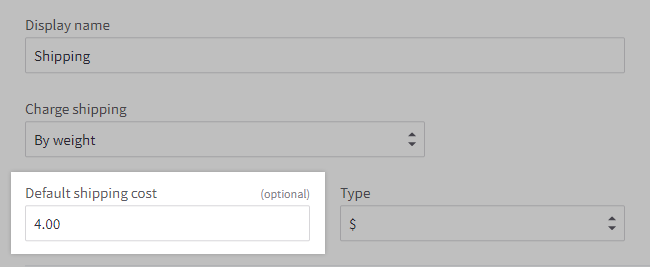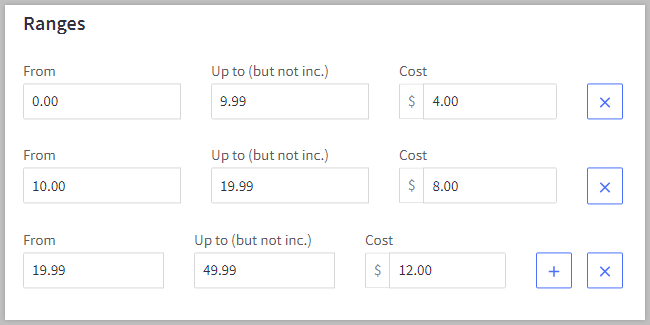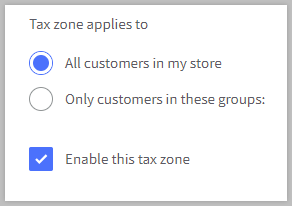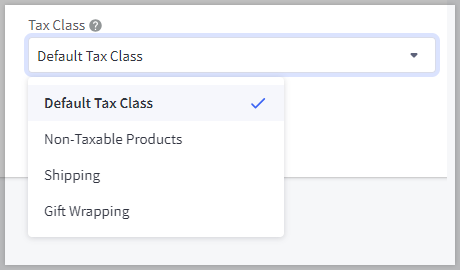Checkout Errors
What We'll Cover
Checkout errors can be in the form of a failed order, typically shipping or payment related, or a completed order that was processed incorrectly, such as incorrect tax being charged. When an order fails during checkout, the customer will receive an error message with details about why it failed. Read through the sections below to determine what is causing the error and how to resolve it.
Shipping Errors
Shipping errors occur when the shopping cart or checkout cannot find a working shipping method for the combination of products and shipping address the customer has entered. If at any point the checkout is not able to find a matching zone or an available service, the customer will receive the following error:

When producing the list of shipping options for the customer, the BigCommerce checkout looks at the customer's shipping country, state/province, and zip/postcode. The checkout then identifies the shipping zone that most closely matches.
Once a shipping zone match has been found, the checkout looks for any flat-rate shipping methods enabled inside that zone. The manager then removes all flat-rate methods that do not apply due to weight or cost restrictions such as non-applicable Ship by Weight ranges, Ship by Order Total ranges, or free shipping over $X methods.
The checkout will then look at real time shipping methods enabled in that zone. If it finds services that match, it sends the product weights and dimensions to the real time quote provider. The real time quote system processes these and returns shipping quotes to BigCommerce. The checkout page then displays all matching viable flat-rate services and real time quotes.
If your customers are experiencing shipping issues, you will need to identify at which point in the process the error is stemming from. Use the following sections to help you troubleshoot and find the cause.
Origin & Zones
Check your Shipping Origin address. Make sure you have the correct country, state/province, and zip/postcode set up. If it is not correct, real time quotes cannot be processed.
Look at your shipping zones. Customers will receive errors if a zone that supports their address is not set up. In addition, verify that all locations you support are covered.
If you see a zone that should support your customer's location, Edit the zone to dive into the zone details for further investigation. Depending on the type of zone created, do the following:
- Selection of countries — Check to see if your customer's country is in the list of Countries.
- Selection of states or provinces — Check to see if your customer's state/province is in the list of States/Provinces.
- Advanced selection — Check to see if your customer's postcode is in the Country and zip/postcode list or that their state/province is in the country and state list.
After reviewing the zone, if everything looks accurate, the issue may lay with the zone's shipping methods.
Check zip/post code formatting. Sometimes customers will provide their zip/postcode in a format other than the way you have entered it, such as entering a 9-digit zip code or leaving out a space in the postcode. If this appears to be the problem, try using wild cards in your zip/postcodes. This will account for any variations in format.
Shipping Methods
Shipping methods determine the shipping options a customer sees at checkout. They can be a flat rate method, like a flat rate based on the order total or weight, or a dynamically calculated charge through a real time shipping service based on shipment details like weight, origin, and destination. Review the methods you're using for troubleshooting tips.
Flat-Rate Methods
When using flat-rate methods based on weight or order totals, make sure that your customer's order falls inside one of the ranges you have specified. If it does not, make sure that you have included a Default shipping cost. The default cost is what the customer will be charged if their order falls outside the specified ranges.
If left blank, orders that fall outside of your specified ranges will default to a different shipping method (flat-rate or real time). If you don't have any other shipping methods set up, no option will be available for the customer, resulting in a shipping error.

When checking your ranges, ensure that you don’t have any coverage gaps. The field Up to (but not inc.) means that the value entered in the box is not covered in the range.
The example below contains a few gaps and shipping error will occur if an orders falls within a gap and no Default shipping cost is entered.
The first range covers up to 9.98 (by entering 9.99 in the field) and the second range starts at 10. A gap of .01 exists and orders weighing 9.99 will result in a shipping error.
The second range covers up to 19.98 (by entering 19.99 in the field) and the last range properly starts at 19.99, ensuring that there is no gap here. However, the range ends at 49.98 (with 49.99 entered in the field); any orders weighing 49.99 and above are not covered.

Updating these ranges to remove gaps, the second range now starts at 9.99, since the first range ends at 9.98. The last range has also been extended out to 999 and now covers larger orders.

Real Time Quotes
The information in this section covers troubleshooting shipping quotes generated using our real time shipping integrations. For help with rates or quotes generated using apps, contact the app developer.
The shipping providers we've integrated with will provide an error log, accessible via store logs, to help troubleshoot shipping errors. Clicking the + icon next to an error will give more details. Common errors include products not having dimensions, orders being over the carrier's weight limits, or incorrect carrier account or API credentials.
See Troubleshooting Real Time Shipping Quotes for more information.

Tax Errors
There are two types of tax errors that can occur during checkout: orders are being charged an incorrect amount or no tax was charged on the order.
The troubleshooting steps for investigating tax-related issues will depend on the method used for calculating tax. There are two ways to set up taxes, using basic tax by or enabling an automatic tax provider. Review the section for the method you're using for troubleshooting tips.
Basic Tax
Double-check the Tax calculation field. This setting controls which address should be used to determine the tax zone that a customer falls under. If you're not sure which one you should be using, we highly recommend contacting your accountant or local tax authority to ensure you are charging tax properly for your store.
Once you've determined the address the system is basing tax on, check that you have a zone created for that address.
If there is a zone, make sure that it's enabled by going to the Tax Rates & Zones tab while editing your basic tax settings. Edit the zone settings and check the Tax zone applies to setting. This determines whether the zone applies to all of your customers or only to those in select customer groups.

If everything is set correctly, make sure that the zone has tax rates by clicking on the Tax rates tab when editing the zone or by selecting Edit rates from the zone’s Action menu when viewing all zones.
If the zone has tax rates, make sure that they are enabled. If the rates are enabled, but the percentages are wrong, update them now. If the zone has multiple rates, ensure that calculation priorities have been set up correctly. After making any changes, test the tax calculation on your storefront using the customer’s address.
If you've found nothing wrong with your tax settings, the issue may be with the products in the order. Products can be assigned a tax classification during creation.

Typically, products are set to use the Default Tax Class, but if you've set up your products to use different tax classifications, the products in question may have an incorrect tax classification applied to them.
If you've found nothing wrong with how your products are set up or with your tax settings, contact our support team for further investigation.
Automatic Tax
When using an automatic tax provider, troubleshooting will be limited.
If taxes are being applied at a flat 10% tax rate, the tax provider has switched to their fallback rate. A fallback tax rate is applied when there is a failure to connect to the automatic tax calculation service, or if there is no shipping origin address set up in the Shipping settings, or if the customer's address could not be validated.
You can optionally use your basic tax setup to calculate fallback tax rates instead of using the flat 10% rate, or disable fallback tax completely (the customer will not be able to check out).
If taxes are being charged incorrectly or if no tax is being charged, check the status of your tax provider to see if there are any performance issues.
You can also use your tax provider's tax calculation tools to confirm proper tax rates are being calculated for a particular region. If there is any inconsistency between the rate reported at the provider's calculator and what is reported by your store, please contact our support team for further investigation.
Payment Errors
Payment errors can occur during checkout or in the control panel when editing an order, such as performing a refund or manual capture. No matter which payment gateway you choose to use, the first troubleshooting step should be to check your store logs. These logs can help you identify and troubleshoot the issue.
The next step would be to double-check that you've entered the correct credentials for your payment gateway setup. Verify that your customer is using a valid credit card (not expired) and that they have sufficient funds in their account.
If the error is happening in the control panel when you're trying to perform an order action, such as a refund or capturing a payment, note that each will have specific requirements for that action.
In the case of refunds, the transaction for the order must be settled by the payment gateway. Some payment gateways dictate that a transaction must be older than 24 hours, but within 60 days before it can be refunded. Check with your payment gateway for specifics.
In the case of authorize only captures, authorization for that capture will have a cut-off point. This time limit depends on the gateway and can range from 7 to 30 days. Check with your payment gateway for specifics.
Below we've provided a list of some of the most common errors you may encounter when using one of our many payment gateways. If this list does not include the error that you are experiencing, we recommend that you contact the payment gateway for information on what the error means and how to resolve it.
Amazon Pay
For a full list of error codes, see Amazon Pay's Error Codes page.
PayPal powered by Braintree
For a full list of error codes, see Braintree's Transactions | Declines page and PayPal's API Error Codes.
PayPal
Error: Seller accepts encrypted website payments only
Cause: This error is displayed because the PayPal Account Profile is set to only accept payments from encrypted buttons. This condition interrupts the payment process and displays the error message.
Resolution: Turn off Encrypted Website Payments in your PayPal account. To do this, follow the steps below:
- Log in to your PayPal account.
- Click the Profile icon to the right of the page, next to the Log out button.
- Once the popup appears, click Profile and settings.
- On the left, click My selling tools from the menu.
- Click Update, to the right of Website preferences.
- In the Encrypted Website Payments section, select Off.
- Click Save.
Error: Security Header is Not Valid 10002
Cause: This error indicates an issue with the login information you are using for your PayPal connection.
Resolution: Remove your credentials, then re-enter them. If you copied and pasted the data, make sure there are no spaces before or after the information. We recommend first pasting them into a text editing program, such as Notepad or TextEdit to ensure this.
If you continue to have issues, contact PayPal Support to have new credentials generated, then enter those new credentials (again pasting into a text editor to avoid extra spaces).
Error: The transaction was refused as a result of a duplicate invoice ID supplied
Cause: This error is seen when an account is being used or has been used with a different store. The Order IDs in your BigCommerce store are the same as those used with your other store, so PayPal is rejecting the transaction as a duplicate.
Resolution: To resolve this issue, find your other store's highest order ID and set BigCommerce order IDs to be much higher to ensure that there is no overlap. If both stores are on BigCommerce, only edit one store's IDs, so they don't overlap.
Error: Response code: 23. Response message: Invalid account number
Cause: The customer entered an incorrect credit card number.
Resolution: Since this is an issue with the customer's credit card, there is not much you can do without having the correct credit card info. If you want to reach out to your customer, the Order ID is provided in the error message. You can look the order up in the Orders section of the control panel and use the email address provided in the order details.
Error: Response code: 26. Invalid Vendor Account
Cause: This error message can be the result of one of the following:
- you just activated your account
- the login information is incorrect
Resolution: Ensure your account is at least an hour old. New accounts do not become active until at least an hour after it was created. Verify that all values (User, Vendor, Partner, and Password fields) are both correct values and proper case (all values are case sensitive).
Authorize.net
Error: This transaction cannot be accepted
Cause: The transaction key was entered into BigCommerce incorrectly or has expired.
Resolution: Regenerate the transaction key, add it to BigCommerce, then test the connection. Steps are provided below.
- Log in to Authorize.net's Merchant Interface.
- Regenerate the transaction key.
- Go to Settings › Payments. Go to the Authorize.net tab and paste the new transaction key under Transaction Key.
- Save. We advise running a test order to ensure that the issue has been resolved.
Error: The referenced transaction does not meet the criteria for issuing a credit
Cause: Authorize.net transactions can only be refunded after approximately 24 hours. Until then, the transaction has not been fully processed.
Resolution: Wait until the order is at least 24 hours old and re-attempt the refund through the Authorize.net dashboard. If the error persists, contact Authorize.net support and provide the order's transaction number, found under the order details.
Error: The merchant login ID or password is invalid or the account is inactive
Cause: This error message can be the result of one of the following:
- the merchant account is inactive
- the API login was entered into BigCommerce incorrectly
- the transaction key was entered into BigCommerce incorrectly or is invalid
Resolution: Regenerate the transaction key, add it to BigCommerce, then test the connection. Steps are provided below.
- Log in to Authorize.net's Merchant Interface.
- Regenerate the transaction key.
- Go to Settings › Payments. Go to the Authorize.net tab and paste the new transaction key under Transaction Key.
- Save. We advise running a test order to ensure that the issue has been resolved.
Error: The customer name on the order's billing address displays as "Unknown Customer".
Cause: This information was not supplied to BigCommerce.
Resolution: Contact Authorize.net to whitelist BigCommerce and allow billing details to be passed along.
NMI
Error: Override Duplicate Threshold Not Allowed
Cause: The Allow Merchant Override setting is not enabled in the NMI virtual terminal. This can only be enabled by an NMI representative.
Resolution: Contact NMI Support and ask them to check the Allow Merchant Override setting in the Processor settings.
 © Copyright 2003 - 2024 BigCommerce Pty. Ltd. Shopping Cart Software
© Copyright 2003 - 2024 BigCommerce Pty. Ltd. Shopping Cart Software